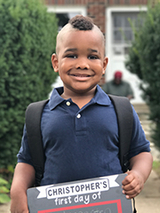Coarctation of the Aorta: Christopher’s Story
Coarctation of the Aorta: Christopher’s Story
At 6 months old, Christopher was a very happy baby, and in most respects, he seemed perfectly healthy — he was growing and gaining weight, and sitting up on his own. Still, there were a few signs that something wasn’t quite right. At times, his breathing was fast and irregular, and he was often tired.

“He would take so many naps during the day,” says his mom, Jen.
When she mentioned Christopher’s symptoms during his regular checkup, his pediatrician listened closely to his heart and found that he had a heart murmur. She advised Jen and her husband, Troy, to follow up with a pediatric cardiologist, and they made an appointment with Paul Stephens, MD, at the CHOP Specialty Care Center in Abington, PA.
A frightening diagnosis
More About Coarctation of the Aorta
When Dr. Stephens saw Christopher, he knew immediately that something was terribly wrong. “He looked at Christopher and said, ‘Does he always breathe like that?’” says Jen. Dr. Stephens examined Christopher and told his parents that he had a congenital heart defect called coarctation of the aorta. In children with this condition, a section of the aorta — the part of the heart that carries blood to the rest of the body — is too narrow, and the lower part of the body does not get enough blood.
“He said we needed to go straight to Children’s Hospital of Philadelphia (CHOP) because Christopher needed to have surgery pretty quickly,” says Jen. “Our world just fell apart.”
Surgery and recovery at CHOP
When they arrived at CHOP, they met with pediatric cardiologist Chitra Ravishankar, MD. Dr. Ravishankar told Jen and Troy that Christopher would need to be treated with medication for several days before he could undergo surgery.
Three days later, J. William Gaynor, MD, one of four pediatric cardiothoracic surgeons at CHOP, repaired Christopher’s heart in CHOP’s state-of-the-art Cardiac Operative and Imaging Complex. Troy's parents, Jen's mother, and Christopher's sister joined Troy and Jen in the waiting room during the surgery. “They wanted to be there for us, and it was the best thing,” says Jen. “They told stories about when my husband was younger to keep our minds off of everything we were dealing with.”
Christopher spent the next eight days at CHOP recovering from the surgery.
“The team in the Cardiac Intensive Care Unit was amazing. Everyone was kind and sweet and patient and understanding. I’ve never experienced anything like that.”
Going home — and growing up

Jen and Troy were thrilled with their son’s progress, but those first few days at home were challenging. “It was really scary coming home the first night,” says Jen. “He had a different cry when he was in pain — it was just heartbreaking.”
Christopher grew stronger over the coming months, and he saw Dr. Stephens regularly for checkups and echocardiograms. Christopher is doing great now, and may require surgery on his aortic or mitral valve when he gets a bit older. At the moment, though, he’s looking forward to starting kindergarten in the fall and doing the things he loves most, like running, playing soccer and wrestling.
“He knows he’s a heart warrior,” says Jen. “He knows that when he was little he had heart surgery, and it made him stronger.”
His parents, too, have been transformed by Christopher’s experience, and they’re eager to share what they’ve learned with other families — starting with this piece of advice: “Take your kids to their checkups,” says Jen. “And pay attention to things that seem a little different to you.”